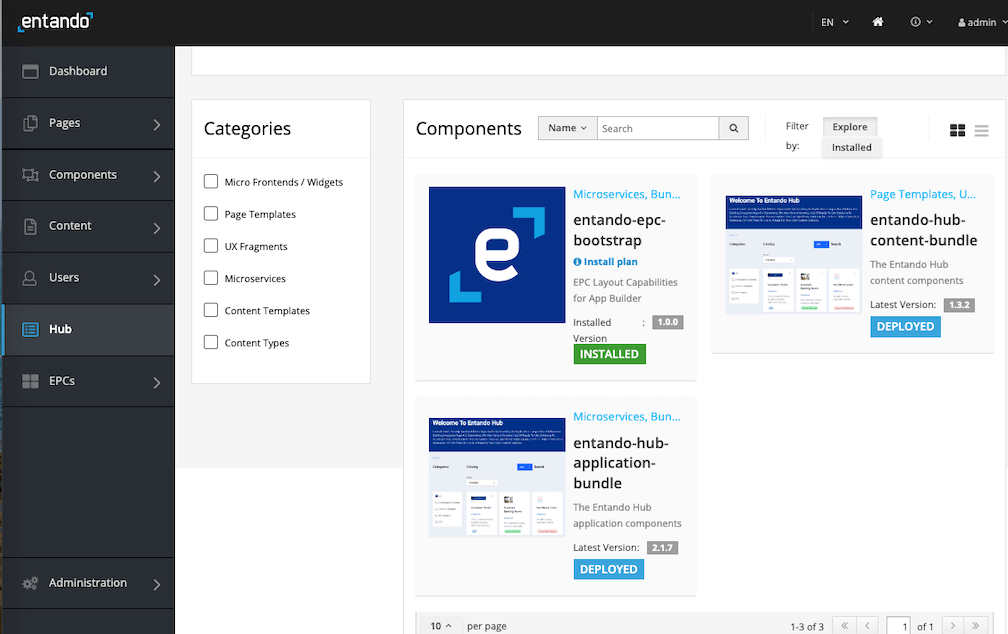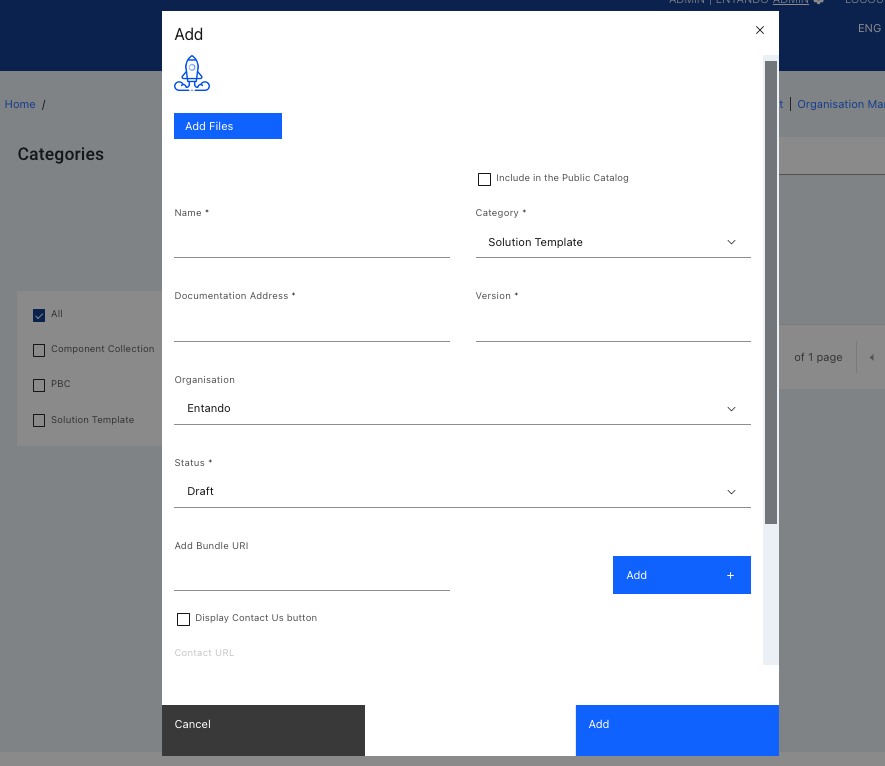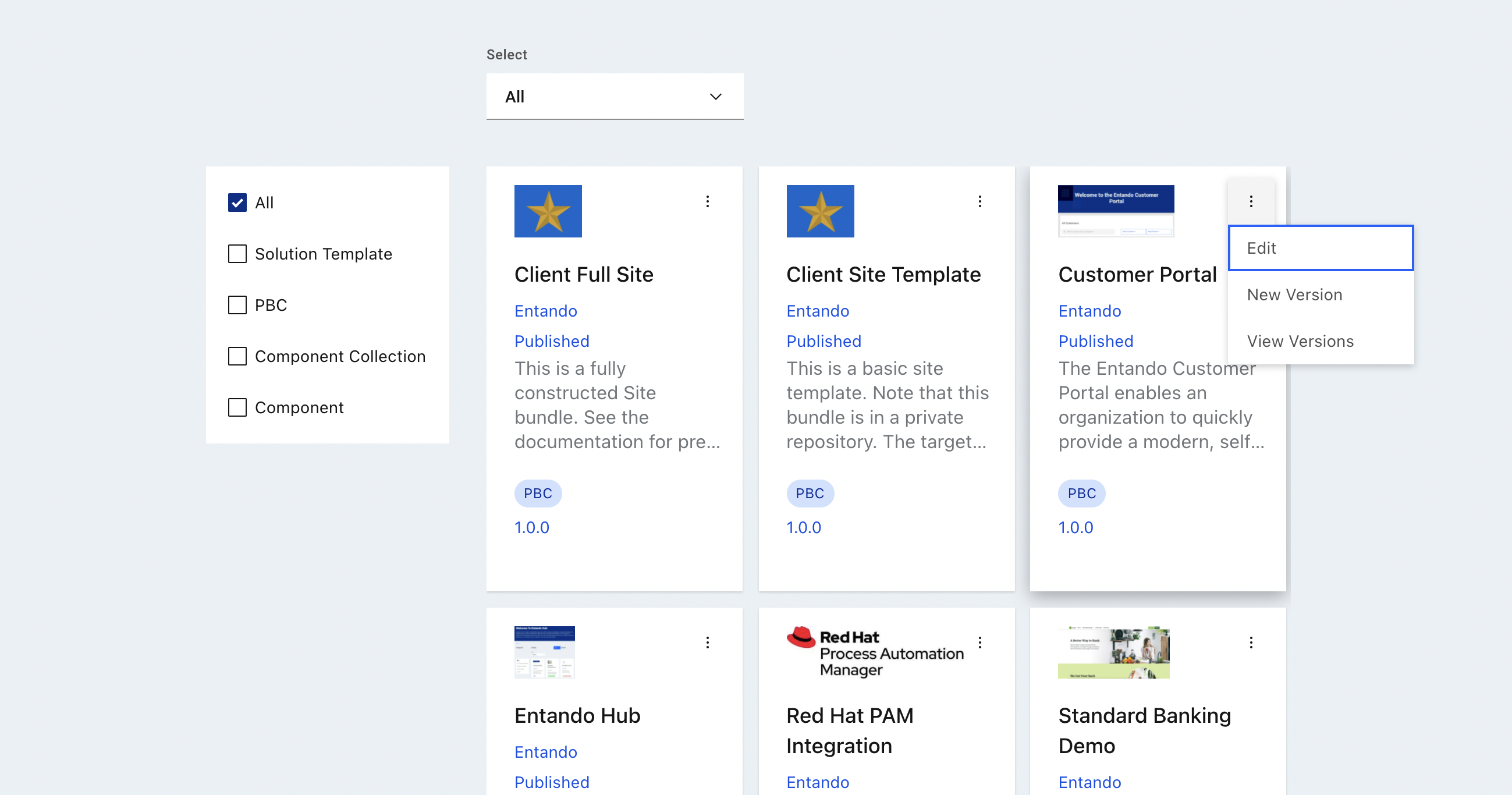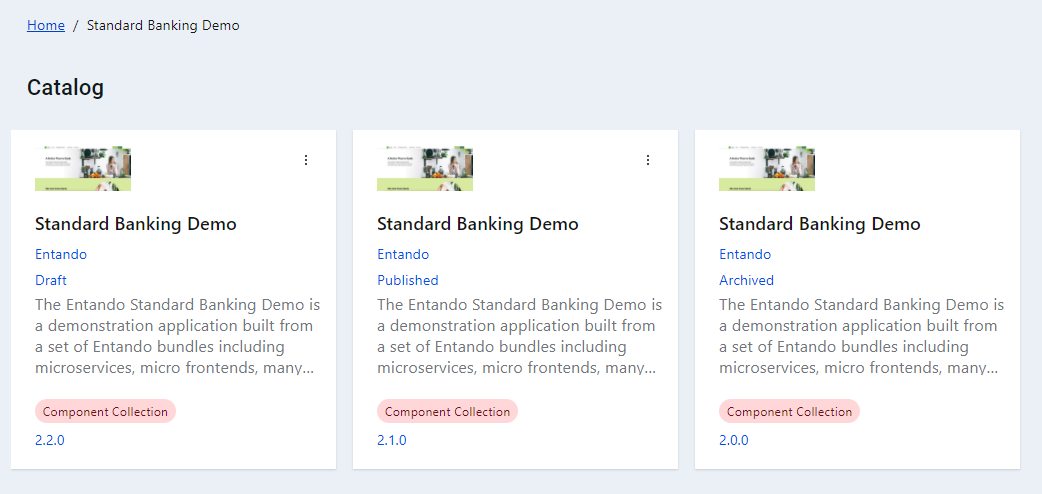# Entando Hub
An Entando Hub enables teams to share components across their organization and between Entando Applications. It can be installed in any Entando 7+ instance and includes API-level integration with the App Builder.
Hub Features:
- Centralize components and business capabilities for use across teams, groups, or clients
- Publish, manage and communicate component features, versions and metadata
- Perform business-level assessment of component readiness
An Entando Application can make use of an Entando Hub in several ways:
The Local Hub, included in the Entando App Builder, displays a collection of components ready to use. They can be used to compose an application or as a starting point to create new components.
Entando Cloud Hub is the public catalog containing packaged business capabilities and components provided by Entando and its partners throughout the world.
An enterprise Entando Hub, developed and curated by Entando clients and partners, can be used to share components within their respective organizations or made available for public use.
This tutorial details the steps to create and utilize an enterprise Hub, including:
- Installation
- Configuration
- Using an Enterprise Hub
- Hub Concepts and Definitions
- Application Details
- Resources
# Installation
An enterprise Entando Hub is installed using the Local Hub and two Entando Bundles. One bundle contains the micro frontends and microservices while the other sets up the initial content and pages for the hub UI.
# Prerequisites
- An Entando Application on any Kubernetes provider. Follow the tutorials appropriate to your environment to install the Entando Platform.
- The ent command line tool, installed and connected to your Kubernetes instance.
# Automatically Access the Entando Cloud Hub from the App Builder
- Log in to your App Builder
- Go to
Hub→Select Registry - Choose
New Registry - In the pop-up window, enter
Entando Cloud Hubandhttps://entando.com/entando-hub-api/appbuilder/apifor the URL, then clickSave - Click on the Cloud Hub in the Registry and continue with the tutorial at Step 4 below
# Manual Installation Steps
- Apply the custom resource definitions for the Hub component bundles:
ent ecr deploy --repo=docker://registry.hub.docker.com/entando/entando-hub-application
ent ecr deploy --repo=docker://registry.hub.docker.com/entando/entando-hub-content
Log into your App Builder instance.
Select
Hubfrom the menu on the left. Your bundles will be visible in the Local Hub as shown in the screenshot below.

- Click each bundle icon and
Installthe bundle, where order of installation is important. Theentando-hub-application-bundlemust be installed first because it provides theentando-hub-content-bundlewith MFEs. It may take several minutes to download the Docker images for the microservices and install the related assets.
# Configuration
Set up permissions to configure the service for the Hub administrator:
- Log in to your Keycloak instance as an admin.
- Give at least one user the ability to manage the hub by granting the
eh-adminrole. Assign theeh-adminrole for thepn-152edaba-0a2ba8fb-entando-entando-hub-catalog-ms-serverclient. See Role Assignment in ID Management for more details. - Give the generated plugin client permission to manage users.
- From the left sidebar, go to
Clientsand select client IDpn-152edaba-0a2ba8fb-entando-entando-hub-catalog-ms-server. - Click the
Service Account Rolestab at the top of the page and selectrealm-managementfrom theClient Rolesfield. - Choose
realm-adminfromAvailable Rolesand clickAdd selected. It should now appear as anAssigned Role.
- From the left sidebar, go to
Access your enterprise hub from the App Builder by navigating to
Pages → Management. FindEntando Hubin the page tree, and clickView Published Pagefrom its Actions.
# Using an Enterprise Hub
# The Hub UI
The enterprise Entando Hub is equipped with a user interface where users, entries, and catalogs are managed. Private and public catalogs can also be configured here.
- Administrator can create and manage users, categories, and organizations.
- Authors and managers have varying levels of access to create and manage entries, otherwise called bundle groups.
- Each catalog can be connected directly to an App Builder instance for easy access.

# User Management
Only a Hub administrator has the authorization to create and manage users.
- Log into your Keycloak admin console
- Go to the
Userssection from the left navigation bar and add a new user. Enter the relevant identity information. - Once saved, go to the
Role Mappingtab and assign the correct role underClient Rolepn-152edaba-0a2ba8fb-entando-entando-hub-catalog-ms-server- for an author, assign
eh-author - for a manager, assign
eh-manager
- for an author, assign
- Log in to the Hub UI as an admin
- Go to
User Managementand clickAdd User - Choose the desired user and select an organization from the drop-down list. If the organization is not available, go to Organization Management to add it.
- Note that an admin user needs to belong to an organization as well, especially for private catalogs that require an API key.
# Create New Entries/Bundle Groups
Click the Add + button at the top of the Hub UI home page to create a new bundle group. In the pop-up window, enter the details for the entry.

- Upload a file of the thumbnail for the bundle group.
- Add one or more bundles for the entry using the
Add +button next to theAdd Bundle URIfield. - Check
Display Contact Us buttonand enter the URL underContact URLto gather more information from the viewer/visitor and manage access to the entry. Typically, the contact URL points to a web form on the owner's web site with a request for access to the entry.
# Create a Private Catalog
A private catalog can be configured in the Hub UI when creating a new organization. There can be many organizations in a single Hub instance, but each organization is allowed one private catalog. Only the Hub admin can create an organization and provide a private catalog for it.
- Go to Organization Management from the top menu
- Click
Add Organization +, enter the relevant information in the pop-up window, and clickSave - The new organization will appear in the current list. Click on the kebab menu to the right of the organization and select
Create Private Catalog. A key icon will appear next to the private catalog. To go directly to this catalog, there is a link under the same kebab menu.
# Generate an API Key
API access to private catalogs requires the use of an API key instead of user credentials. When connecting a registry from the App Builder, the API key is required to configure a private catalog.
- API Keys are attached to a specific user account so login as a user assigned to the organization of the private catalog.
- From the Hub UI homepage, click on the gear icon right of the
Add +button and selectAPI Key Management. - Click
Generate API Key, enter a name, and confirm with the blue generate button. Save the key for future reference.
# Add a Catalog as a Registry in your App Builder
Any enterprise Hub instance can be accessed from the Entando App Builder of another Entando Application.
- Go to the Hub from the left navigation bar in the App Builder and click
Select Registry - Choose
New Registryfrom the drop-down menu - Enter the registry name and the API endpoint for the catalog:
The API endpoint is
https://YOUR-BASEURL/entando-hub-application-152edaba/entando-hub-catalog-ms/appbuilder/apiwhereYOUR-BASEURLis the hostname of your Entando ApplicationPrivate Catalog
For a private catalog, the URL has an added catalog ID number from the catalog's HTTP address. Go to the published catalog page from the App Builder and find the address in the browser. The number after/catalog/is YOUR-CATALOG-ID#.- The endpoint to access the catalog is
https://YOUR-BASEURL/entando-hub-application-152edaba/entando-hub-catalog-ms/appbuilder/api/?catalogId=YOUR-CATALOG-ID#
E.g., The catalog address:
https://quickstart.k8s-entando.org/entando-de-app/en/entando_hub.page#/catalog/1/→1is YOUR-CATALOG-ID#The URL to enter:
https://quickstart.k8s-entando.org/entando-hub-application-152edaba/entando-hub-catalog-ms/appbuilder/api?catalogId=1- The endpoint to access the catalog is
- If an API key is required, ask your Hub administrator or generate a key if you have a Hub user account.
# Hub Concepts and Definitions
# Entry/Bundle Group definitions
The key entities in an enterprise Hub are:
Bundle Group: A bundle group is a group of one or more Entando Bundles.Bundle Group Version: A bundle group can have one or more versions, each with a particular status.Bundle: An Entando Bundle is the deployment unit within an Entando Application. A bundle can contain one or more components such as micro frontends, microservices, or any of the component types available in Entando.Category: Each bundle group belongs to a specific category. The initial possible categories are solution template, packaged business capability (PBC), and component collection. An admin of an enterprise hub can create and refine the categories as desired.Organization: Bundle groups belong to a single organization. Authors and managers can only update bundle groups for their own organization.User: User identity is managed within Keycloak, where users are granted roles within a hub instance. Users must be assigned to a specific organization.
Note:
- A private repository can be used for a bundle, but this requires an additional Kubernetes Secret before deployment via the App Builder.
# Roles
Three roles are defined to provide access to the enterprise Hub features:
eh-author: An author can create and edit bundle groups for their organization and submit them for publication. They can generate an API key.eh-manager: A manager has the permissions of an author, but can also approve a publication request for their organization. They can generate an API key.eh-admin: An admin has full access to create, update, and delete bundle groups and users for the entire hub instance. An admin can also create categories and organizations, assign users to an organization, and generate API keys.guest: Any user without one of the preceding roles is considered a guest in the enterprise hub and is given a read-only view of the public catalog. This is also true for unauthenticated users.
# Bundle Group Status
The possible statuses for the versions of a bundle group are:
Draft: This is the default status for the first version of a bundle group.Publication Request: Aneh-authorsets a version to this status to request aneh-manageroreh-adminto review the version and mark it for publication. Aneh-manageroreh-adminmay edit versions with this status.Published: Versions with this status are visible in the home page list of available bundle groups and also available in the App Builder-facing API. Aneh-manageroreh-adminmay edit published versions.Archived: Previously published versions are assigned this status. No edits can be made to an archived version.Deletion Request: Aneh-manageroreh-admincan delete versions once this status has been set.
Notes:
- An eh-author can change any field except organization while a version is in draft.
- There is no automated notification process when a publication request is made for a bundle group version.
# Bundle Group Versions
The list of bundle group versions can be seen by clicking View Versions on any entry in the catalog:

The following rules apply to bundle group versions:
- Once the first version of a group is published, the organization, name, and category can no longer be changed.
- A new version of a bundle group can be created (via the
New Versionoption) after the first version has been published. - There can be at most two active versions: one draft or publication requested version and one published version.
- When a new version is published, the previous version is set to archived.
- Archived versions are only visible in the versions view and are not shown elsewhere in the user interface.

# Application Details
An Entando Hub includes the following key components:
# Micro Frontends / Widgets
Entando Hub App: This is the main micro frontend which contains the management UI for the hub entities noted above.Entando Hub Login: This is an optional login component which can be used in a page’s top navigation.
# Microservices
A single Spring Boot microservice provides two REST endpoints:
- The first is a backend-for-a-frontend (BFF) service for the hub UI and contains the various entity APIs.
- The second provides methods that support the Entando App Builder integration (7.0+).
# Content
The content bundle (entando-hub) includes a custom template and a page preconfigured with the main hub micro frontends.
# Resources
# Source Code
Entando open source examples and tutorials are available on GitHub. Reference the Hub sample project for instructions to build the project from source code: